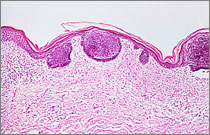Liver cancer
| 2020 | ||
|---|---|---|
¹ per 100,000 persons, age-standardised according to the old European standard population * calculated using the period method for 2019 / 2020 | ||
| Women | Men | |
| Incidence | 3,030 | 6,740 |
| Age-standardised incidence rate¹ | 3.7 | 10.0 |
| Deaths | 2,781 | 5,676 |
| Age-standardised mortality rate¹ | 3.1 | 8.0 |
| 5-year prevalence | 4,300 | 9.600 |
| 10-year prevalence | 5,900 | 12,800 |
| Relative 5-year survival rate* | 17 % | 17 % |
| Relative 10-year survival rate* | 12 % | 11 % |
Although liver cancer is relatively rare, it is one of the most frequent causes of cancer death due to its poor prognosis. In Germany, there are currently about 9,800 new cases per year, with almost 8,200 deaths.
Prognosis mostly unfavourable
The relative 5-year survival rates for women and men are around 17 percent. Around 59 percent of malignant liver tumours arise from
liver cells (hepatocellular carcinoma) and 31 percent from cells of the intrahepatic bile ducts (cholangiocarcinoma).
The latter proportion is higher among women.
Since 1999, the age-standardised incidence and mortality rates have risen slightly for both sexes. For some years now, however, there have been signs of a decline in both rates for men.

![]() Relative 5-year survival by UICC-stage and sex, ICD-10 C22, Germany 2015 – 2016
Relative 5-year survival by UICC-stage and sex, ICD-10 C22, Germany 2015 – 2016
Alcohol and viruses are the most important risk factors
The main risk factor for liver cancer in Germany is cirrhosis of the liver. In Germany, its most common causes are chronic hepatitis C virus infection and high alcohol consumption. Non-alcoholic fatty liver disease (NAFLD) increases the risk of liver cancer and is becoming increasingly important. Among other things, NAFLD can occur due to diabetes mellitus or a metabolic syndrome. These, in turn, are often triggered by obesity. According to a research study, alcohol consumption in Germany is responsible for 15 percent of new liver cancer cases in women and 35 percent in men.
A chronic hepatitis B virus infection, even without liver cirrhosis, is a risk factor for liver cancer. This risk factor is particularly important in Africa and South East Asia. Smoking also increases the risk of the liver cancer. The consumption of food containing the mould toxin aflatoxin B1 is relevant today mainly in less developed countries. Hereditary metabolic diseases such as hemochromatosis, porphyria or alpha-1-antitrypsin deficiency can also increase the risk of liver cancer.
Early detection examinations for the general population are not part of the statutory screening services. Patients with liver cirrhosis, chronic hepatitis B or C infection or steatohepatitis should be offered regular ultrasound scans. The measurement of blood values (alpha-fetoprotein) plays a minor role.
Liver cancer and cancer of the bile ducts
Approximately 65 percent of tumours within the liver (ICD-10 C22) develop from liver cells (hepatocellular carcinomas) and about 26 percent from cells of the bile ducts (intrahepatic cholangiocarcinomas). However, cancers of the bile ducts also occur outside the liver as distal cholangiocarcinomas and Klatskin tumours and are classified under code C24 according to the current classification system. The following figure shows the distribution of hepatocellular carcinomas as well as all tumours of the bile ducts according to sex. In women the total proportion of cholangiocarcinomas is higher than that of hepatocellular carcinomas. In men, hepatocellular carcinomas still predominate.

![]() Distribution of malignant neoplasms of the liver and biliary tracts by histological type and sex, ICD-10 C22 and C24, Germany 2015–2016
Distribution of malignant neoplasms of the liver and biliary tracts by histological type and sex, ICD-10 C22 and C24, Germany 2015–2016
Date: 21.03.2024






